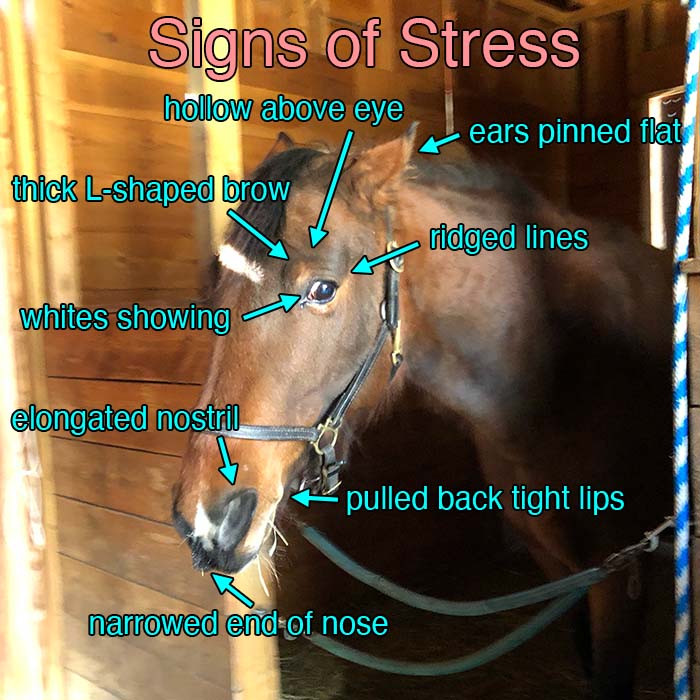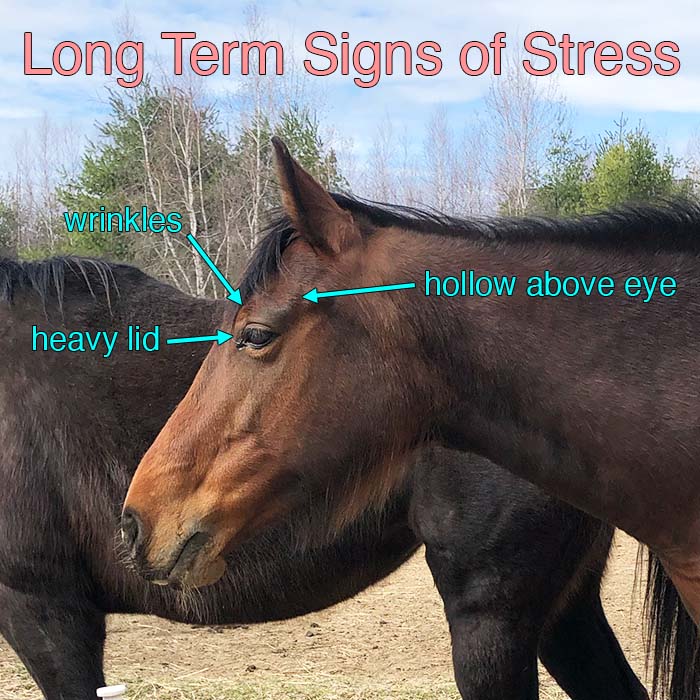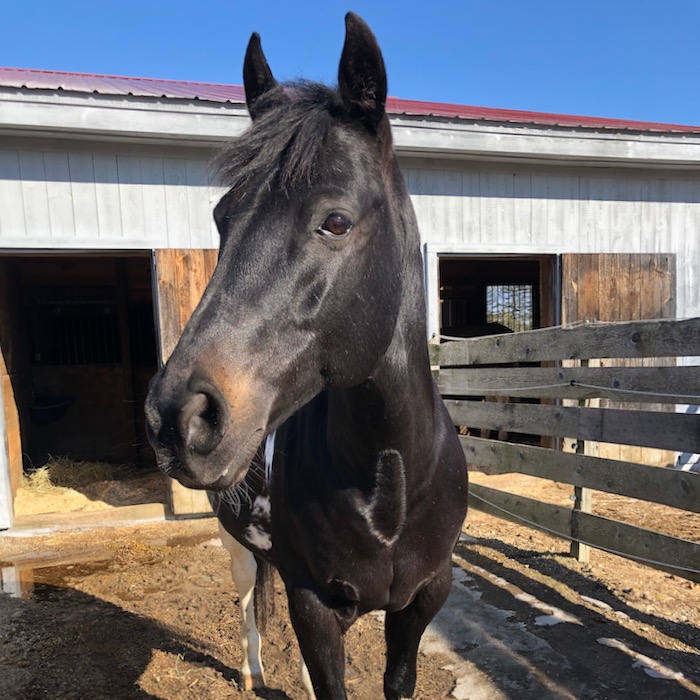Have you ever met someone in their 70s for the first time and your immediate reaction was what a lovely man? Conversely, have you had someone walk your way and your gut reaction was to not make eye contact for fear a having to speak to them, sure that their words would be sharp barbs? What was it that tipped you off? There is the big picture body posture, but equally (if not more) important clues are in the face. After a lifetime a happy person develops laugh wrinkles around the eyes. Yes, the face sags, but in a kind way. The face folds a different way if a person has carried years of anger with them. Then the wrinkles are tightly pinched around the mouth, and those lines around the eyes express distrust. Horses are the same.
I’m currently working with a mare named Hazel. She’s only seven, but her face carries a lot of history. Her owner asked for my help because Hazel bites. Not just as a threat, but meant to maim. Hazel believes that it’s best not to wait to see if her body language is listened to, but that if she feels threatened, that she has to strike. Sadly, she had come to believe that the entire world was threatening. Hazel didn’t feel that she could let her guard down, not around people or other horses. Luckily for her, last year Hazel was adopted by a kind woman. Life improved, but it still didn’t take much to trigger Hazel into being aggressive.
Here’s what Hazel looks like when someone comes into her safety bubble. Horses are innately calm and peaceable animals. It takes a lot of stress to push a horse to have this as their default.

I started working with Hazel at the beginning of March. We’ve made much progress. Her safety bubble has shrunk and I can now stand in the barn aisle without her slamming into the stall guard with her teeth bared. She has even been looking up at me with forward ears and an inquisitive eye. What I’ve been doing has even improved her relationships with the other mares in her pasture, which is now a calmer and more peaceable place. But there’s still much to do. It’s not yet safe for me to walk within striking distance.
Hazel’s face belies how long she’s lived with a default of stress. It’s not just the face that she shows when she’s threatening those around her. I can see it on the face that she wears all of the time. The wrinkles on her eyelids remain even when she’s relaxed, and her eyelid is thick from overuse. The hollow above her eye is deeper than it should be for a young horse.

But Hazel’s world is already less scary for her. She’s learning that when stressed that she has an option other than to attack. She’s learning that a relaxed demeanor gets her what she wants. Hazel is beginning to learn that not everything that happens near her is a threat. (I’m not getting into the training protocols for that in this post. Another time!) This change in her world perspective is already beginning to show on her face. In a few months I’ll share another photo of Hazel. I think we’ll see a difference!
These long term signs of stress can be subtle. Here’s a photo of Tonka, who is a confident and happy horse. He’s twice as old as Hazel, but doesn’t have that hollow above the eye.

Here’s a closeup. Even alert his eye doesn’t have those worry wrinkles, and the lid near the eyelashes lacks the thickness that you see with Hazel.

Horses don’t get laugh wrinkles like humans do, but their faces carry life history and emotion as much as ours do. What do you see in your horse’s face?


I feel so bad that Hazel’s life has been so hard for her. The work she does with you will make her calmer and healthier!
It’s good to be reminded that we’re all a product of our environment and could all use more kindness.
Yes. Kindness and empathy all around.
The work you are doing with Hazel has had a profound effect on her in a few short months. I’m excited to see where the future brings us! ❤️
It makes me so sad to see a young horse like Hazel who has probably seen more than her share of cruelty, or pain. She’s very lucky to have found an owner who wants to treat her with kindness and make her world a better place, and lucky to have you to working with her towards that goal.
Most of the time, when I look at my Kat’s face, I see a beautiful, calm girl who just wants to please and be loved. But she does have her moments of stress that show all over her face.
After the last year of mostly being at home, she has become pretty buddy sour with her pasture mate/best friend, though thankfully not dangerously so. We’ve been working on it at shows by allowing the girls to be together only when they’re working (warming up, waiting their turn at the gate for a run, etc.). Then, when they come back to the trailer (tied on opposite sides) they get to relax and snooze. I’d love your take on our approach…
You’re on the right track with the friend-bound training. Only one thing to add – after your horse relaxes at the trailer, lead her away to a spot of grass to graze. Then return before she gets anxious. Repeat. Lead further away. Perhaps behind a bush where the sightline to the friend is limited. In this way she’ll learn that you taking her away from the friend brings good things and that you’ll always bring her back.
Thanks! We’ll add that!
This was fascinating. I realized it was all stuff I knew, but haven’t LOOKED for. Now I will!
It’s good to remind ourselves to look at our horses with fresh eyes.